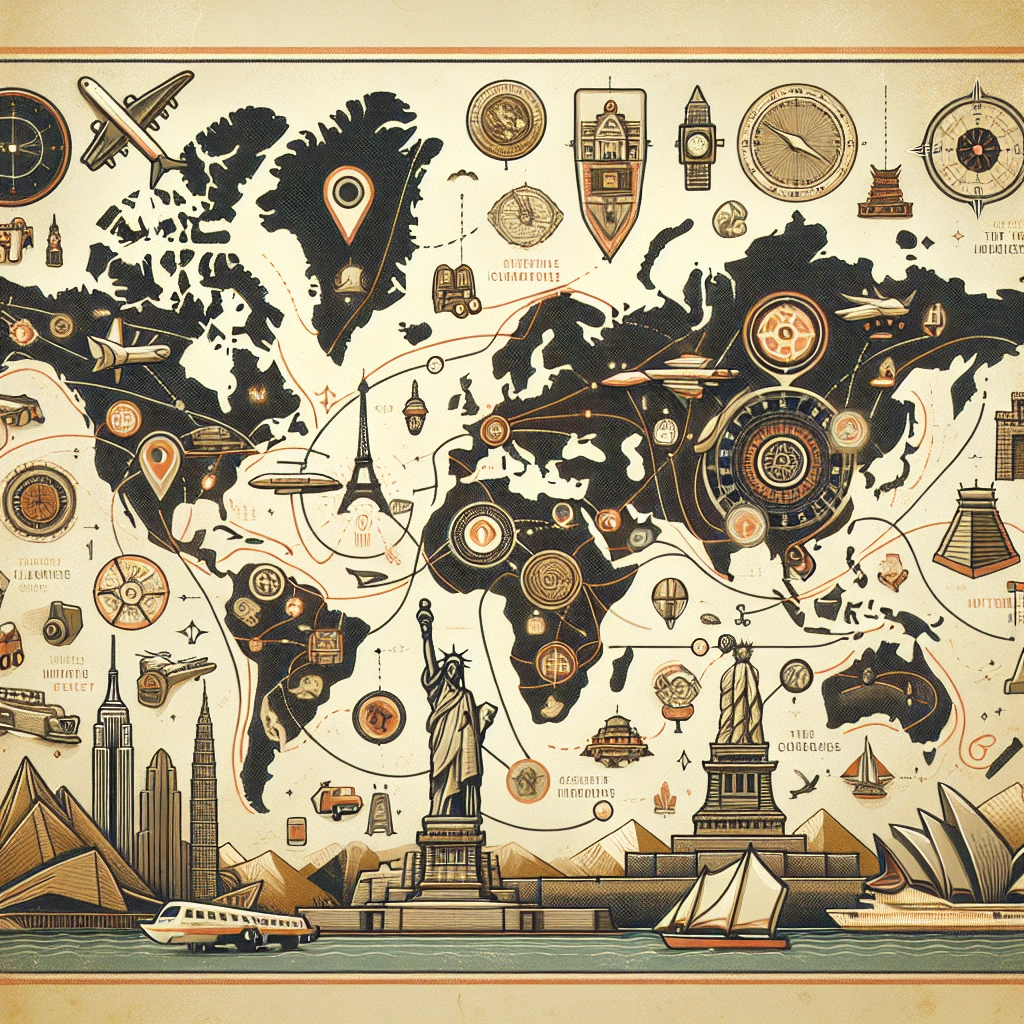[ad_1]
Throughout history, humanity has erected magnificent structures that stand not only as feats of architectural genius but also as testimonies to our aspirations, culture, and shared history. From ancient civilizations to modern engineering marvels, the "Wonders of the World" encompass a range of iconic landmarks whose stories resonate deeply with the values and achievements of their time. This article delves into the tales behind some of these remarkable sites, revealing the cultural significance and historical contexts that shaped them.
The only surviving wonder of the ancient world, the Great Pyramid of Giza, was constructed around 2580-2560 BC during Egypt's Fourth Dynasty. Originally standing at approximately 146.6 meters, it was the tallest human-made structure for over 3,800 years. Built as a tomb for Pharaoh Khufu, this monumental project required a workforce of thousands and an in-depth understanding of mathematics and engineering. The pyramid embodies the ancient Egyptians' belief in the afterlife, showcasing their remarkable craftsmanship and insatiable quest for immortality.
While their existence remains debated among historians, the Hanging Gardens are often attributed to King Nebuchadnezzar II, who purportedly built them for his wife, Amytis, to remind her of her lush homeland. Descriptions suggest an extraordinary terraced garden filled with exotic plants. If they did exist, the gardens symbolized the human endeavor to create beauty and prosperity in an arid landscape, reflecting the sophistication of ancient Mesopotamian society.
This massive statue of the Greek god Zeus, sculpted by Phidias around 435 BC, stood in the Temple of Zeus in Olympia, Greece. Made of ivory and gold-plated bronze, it celebrated not just the deity but also the unity of the Greek city-states through the Olympic Games. The statue was both a religious icon and an artistic masterpiece, embodying the Greek ideals of beauty and form.
Dedicated to the goddess Artemis, this temple was an architectural wonder adorned with 127 columns, each standing 18 meters tall. Completed around 550 BC, it was not only a place of worship but also a bustling center of commerce. The temple was a symbol of the economic power of Ephesus and the devotion of its people, although it was destroyed and rebuilt multiple times throughout history.
Built as a tomb for Mausolus, a satrap in the Persian Empire, this structure combined Greek, Egyptian, and Lycian architectural elements. Completed around 350 BC, it was adorned with intricate sculptures and stood approximately 45 meters high. The term "mausoleum" itself originates from Mausolus's name, signifying the enduring appeal of his lavish tomb.
This towering statue stood at the entrance of the harbor of Rhodes, celebrating the island's victory over Cyprus in 305 BC. Created by sculptor Chares of Lindos, it was made of bronze and stood approximately 33 meters high, representing the sun god Helios. The Colossus symbolized freedom and was a testament to the city's wealth and power, although it stood for only 56 years before toppling in an earthquake.
Constructed on the small island of Pharos around 280 BC, this lighthouse was one of the tallest structures of the ancient world, reaching about 100 meters. It was built to guide sailors safely into the bustling harbor of Alexandria, serving both a practical and symbolic purpose as a beacon of knowledge and civilization, enhancing Alexandria's status as an intellectual center.
In 2007, the New7Wonders Foundation conducted a global poll to identify a new list of wonders reflecting contemporary heritage. This endeavor highlighted remarkable sites worldwide, reinforcing the connection between humanity’s past and present.
Spanning over 21,196 kilometers, the Great Wall was constructed between the 7th century BC and the 16th century AD, primarily to protect China from invasions. The wall represents the strength of a civilization dedicated to safeguarding its culture and territory, embodying both perseverance and engineering prowess.
Known as the "Rose City," Petra's elaborate rock-cut architecture and advanced water conduit system reflect the ingenuity of the Nabataean civilization. Established in the 5th century BC, it served as a crucial trade hub, blending various cultural influences that highlight the region's historical significance.
Designed by Brazilian engineer Heitor da Silva Costa and completed in 1931, the statue of Christ the Redeemer overlooks Rio de Janeiro, symbolizing peace and Christian faith. Beyond its religious symbolism, it serves as a cultural icon of Brazil, showcasing art deco style within a breathtaking natural landscape.
This Incan citadel, built in the 15th century, is renowned for its sophisticated dry-stone construction, terraced agriculture, and breathtaking mountain scenery. Rediscovered in 1911, Machu Picchu now represents the grandeur of Incan civilization and the harmonious relationship between nature and architecture.
A prominent Mayan city from between 600 AD and 1200 AD, Chichen Itza features various architectural styles, including the famous El Castillo pyramid. This site highlights the sophistication of Mayan astronomy, mathematics, and urban planning, serving as a place of worship and trade.
An enduring symbol of ancient Rome, the Colosseum was completed in AD 80 and could hold up to 80,000 spectators for gladiatorial contests and public spectacles. Its grandeur speaks to Rome's architectural innovation and the social and political dynamism of its time.
Built between 1631 and 1648 by Mughal Emperor Shah Jahan in memory of his wife Mumtaz Mahal, the Taj Mahal is a stunning symbol of love and architectural beauty. This UNESCO World Heritage site expertly combines Persian, Islamic, and Indian architectural styles, drawing millions of visitors every year as a testament to eternal love.
The Wonders of the World are more than just tourist attractions; they encapsulate the stories of civilizations, their triumphs, and their tribulations. These iconic landmarks remind us of the power of human creativity, the quest for meaning, and the desire to leave a mark on the world. As we explore these majestic sites, we also reconnect with our shared heritage, an enduring narrative that transcends time and cultures, inviting us to ponder the legacies we will leave for future generations.
[ad_2]
 Wanderlust Wonders: The Top 10 Must-Visit Destinations Around the World
Wanderlust Wonders: The Top 10 Must-Visit Destinations Around the World Wanderlust Wonders: Top 10 Must-See Destinations for Your Bucket List
Wanderlust Wonders: Top 10 Must-See Destinations for Your Bucket List Hidden Paradises: Discover the World's Most Secluded Islands
Hidden Paradises: Discover the World's Most Secluded Islands Unlock Your Wanderlust: Essential Tips for Effortless Travel Planning
Unlock Your Wanderlust: Essential Tips for Effortless Travel Planning Pack Smart: Essential Tips for Hassle-Free Travels
Pack Smart: Essential Tips for Hassle-Free Travels Wonders of the World: Unveiling the Hidden Cultural Gems
Wonders of the World: Unveiling the Hidden Cultural Gems Unforgettable Journeys: The Most Incredible Travel Records You Need to Know
Unforgettable Journeys: The Most Incredible Travel Records You Need to Know Essential Stops on Your Nicaragua Itinerary
Essential Stops on Your Nicaragua Itinerary
The exploration of the Wonders of the World provides a fascinating glimpse into humanity's architectural and cultural achievements. Each site mentioned has a unique story that reflects the values and aspirations of the civilizations that created them. The Great Pyramid of Giza, as the only surviving ancient wonder, stands out for its historical significance and engineering prowess. It raises questions about how such monumental structures were built with the technology available at that time. Similarly, the Great Wall of China exemplifies human perseverance and dedication to protecting one's culture over centuries. It's interesting to consider how these sites not only served practical purposes but also became symbols of national pride and identity. This article does well to highlight both ancient wonders and newer ones, demonstrating that human creativity continues to thrive across different eras. The contrast between ancient monuments like Machu Picchu and modern marvels like Christ the Redeemer invites us to reflect on how our understanding of architecture has evolved while still being rooted in cultural significance.
The article does a commendable job in summarizing the significance of both ancient and new wonders around the world. As I read about each landmark, I couldn’t help but appreciate not just their beauty but also their historical contexts. For instance, Petra's intricate rock-cut architecture illustrates not only engineering skill but also how trade routes influenced cultural exchanges in ancient times. Similarly, Chichen Itza serves as a reminder of Mayan advancements in astronomy and mathematics, which are often overlooked in discussions about history. What strikes me is how these structures have transcended their original purposes; they are now symbols representing entire nations or cultures, attracting millions each year as sites of pilgrimage for knowledge seekers and tourists alike. Additionally, it's intriguing to consider what future generations will deem worthy as 'wonders'—perhaps even our current architectural feats will hold similar reverence centuries from now.
This article highlights significant landmarks that have stood the test of time, showcasing humanity's creative spirit across different cultures and eras. The Great Wall of China particularly caught my attention; it represents not only a physical barrier but also a cultural testament to resilience against adversities faced throughout history. Its extensive length is indicative of an ongoing effort by generations to protect their civilization—a theme prevalent in many wonders listed here. Additionally, exploring the diverse architectural styles seen at places like Machu Picchu reveals much about Incan society’s ingenuity and relationship with nature—a contrast to urban life today where nature often seems secondary in our constructions. The mention of both ancient wonders such as the Statue of Zeus at Olympia alongside modern marvels like Christ the Redeemer showcases a continuum in human expression through art and architecture over millennia.
The diversity among the Seven Wonders presented in this article underlines humanity's multifaceted approach towards building monuments that serve various purposes—spirituality, protection, trade, or commemorating loved ones. Each wonder encapsulates its era's technological advancements as well as social dynamics; for example, I find it fascinating how something like The Colossus of Rhodes symbolized victory yet existed for such a brief time before natural forces claimed it—a poignant reminder of impermanence amidst human endeavor. Furthermore, comparing this with modern constructions such as the Taj Mahal brings up interesting discussions on beauty standards across cultures through ages—how has our perception evolved? Overall, this piece encourages readers not only to admire these structures but also to reflect on what they reveal about past civilizations' values while considering what we might build today that future generations would find equally remarkable.
'Wonders' often evoke thoughts primarily around aesthetics or tourism potential; however, this article effectively highlights their deeper significance within respective historical contexts surrounding each structure. Take for example The Lighthouse of Alexandria—it wasn't merely an engineering feat; it served an essential purpose for maritime navigation at its time! Its role illustrates how functional designs often intertwine beautifully with artistic expressions throughout history—a narrative seen consistently among other wonders discussed here too! Each site tells tales beyond just bricks or stones laid together—it speaks volumes about societal needs during particular periods whilst reflecting ambitions toward creativity lasting beyond individual lifetimes—something we continue aspiring towards today! This makes me ponder: How might contemporary society recognize new 'wonders'? What stories will they tell future generations?
'Wonders' invoke awe—this article captures why through comprehensive insights into their histories! I was intrigued by references made regarding both ancient (like Mausoleum at Halicarnassus) & modern (such as Petra) feats showcasing architectural evolution across timeframes emphasizing cultural influences shaping societies along paths previously untraveled! Each landmark embodies collective human aspirations—they are tests against nature itself while capturing emotions tied closely with legacy building intertwined within artistry itself! Learning about varied forms—from sacred temples celebrating deities’ worships (Temple Of Artemis) down roads leading towards commercial hubs like Chichen Itza shows distinct interconnectivity among inhabitants thriving within those landscapes—reminding me always there’s more than meets eye when exploring stories behind physical constructs!
'Wonders' encompass vast narratives tightly woven into fabric defining collective identities & aspirations prominent throughout shared experiences globally captured beautifully here! Considering themes introduced surrounding greatness imbued amidst engineering prowess demonstrated through various landmarks resonates deeply personally given ongoing quest seeking understanding historical context unfolding around us even now amidst shifting paradigms enveloping everyday existence today! From majestic pyramids standing sentinel over millennia past alongside contemporary icons (Christ redeemer)—these embodiments invite reflections upon legacies left behind whilst forging connections bridging gaps historically speaking alike further inviting dialogues examining roles played via respective societies contributing legacies forming lasting impressions upon humanity!
'Wonders' manifest remarkable milestones achieved within journey defining humankind’s collective history vividly illustrated here capturing readers’ imaginations compellingly drawing attention toward intricacies threaded into tales shaping civilizations themselves reflected architecturally speaking! Whether diving deep beneath surfaces exploring grandeur showcased through Roman Colosseum’s spectacles down pathways traversed visiting sites echoing resilient spirits resiliently striving toward meaning amid uncertainties faced collectively echoes continuous quest uplifting camaraderie across backgrounds uniting strangers sharing awe inspiring moments engaged beneath shared skies experiencing profound connections transcending barriers bridged via creativity pulsating vibrantly alive still today!
This piece brought forward many points worth pondering regarding legacy left behind by previous civilizations! Each wonder holds stories retelling triumphs along struggles encountered paving ways forward enhancing understanding beyond mere tourism attractions—fascinating aspects emerge revealing layers threading heritage deeply rooted desires spanning epochs! Reflection upon enduring symbols resonates personally asking questions surrounding our own impacts moving forward shaping future narratives intending preserve sentiments echoed by predecessors!
Exploring 'Wonders' evokes curiosity around interplay between artistry & functionality woven intricately throughout histories depicted here effectively highlighting efforts enduring far beyond immediate grasp facing challenges inherent existing landscapes transforming realities persistently revisiting core values defining lives led previously inspiring pursuits remain timeless reminders serving ultimate goals established within mankind reaching beyond material existence ultimately aiming towards greater understanding forging pathways inviting dialogues sparking inquisitive minds eager continue learning from journeys undertaken before ours!